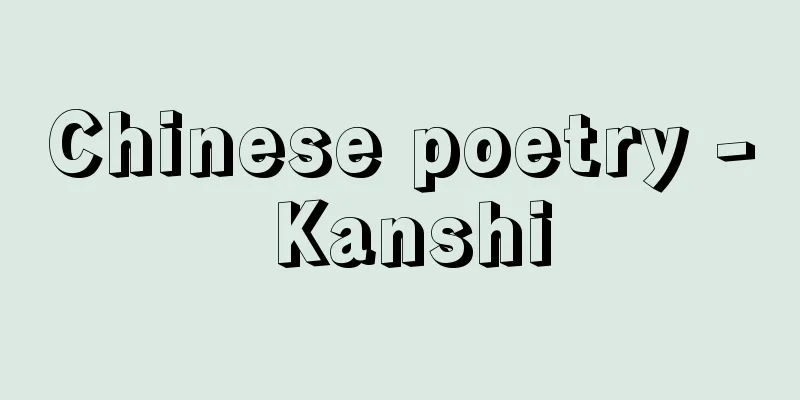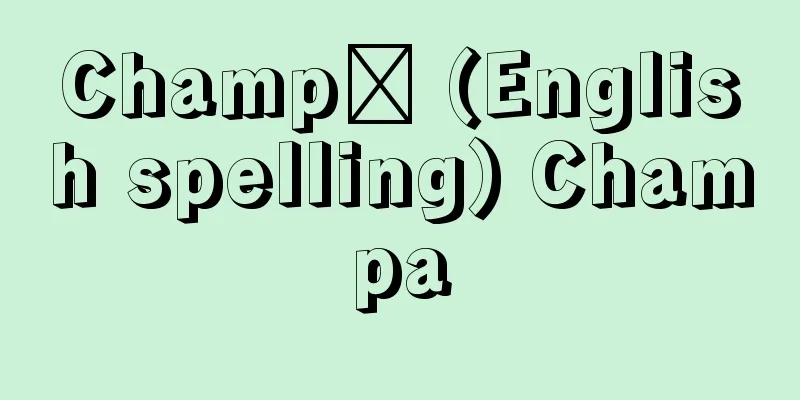Chinese poetry - Kanshi

|
Classical Chinese poetry (or, more narrowly, poetry from the Han dynasty) and poetry created in Japan in that form. Kanshi, a traditional Chinese verse literature, values rhythmic harmony. Its form and style evolved and reached completion during the Tang dynasty. In other words, the poetic style was divided into the ancient style (koshi and gafu) and the modern style (ritsu shi and zekku), and rules were established for the number of lines and words in a line, the rhythm of each word, and the rhyming of the end of a line. For more information, see the chapter on "Chinese poetry" in the "Poetry" entry. In Japan, it began in the Omi Dynasty, when Prince Otomo and Prince Otsu appeared, and poetry for imperial banquets at the imperial court became the center of poetry. Influenced by the poetry of the Six Dynasties, poems of poems appeared, and at poetry banquets, each person was given a set of rhyming characters to compose their poems, but there were also many imitative poems that sought examples of verse from works such as "Wen Xuan" and "Gyokudai Shin'eishu." From the Yoro period (717-724) to the Tenpyo period (729-749), poets were invited to the residences of Prince Nagaya and Fujiwara no Muchimaro to compete with each other in poetic talent, and Fujiwara no Umakai and Isonokami Otomaro were active in the country, and the influence of not only the poetry of the Six Dynasties but also that of Wang Bo and Luobin Wang of the early Tang Dynasty can be seen. Looking at the Kaifuso, a collection of ancient poetry, the overwhelming majority of poems are five-character poems, and many of them lack regular rhythm. The early Heian period was the heyday of Tang-style culture, when imperial poetry anthologies such as "Ryounshu", "Bunkashureishu", and "Keikokushu" were compiled, and poets such as Emperor Saga, Ono Minemori, and Sugawara no Kiyokimi emerged. The influence of newly imported Chinese poetry anthologies led to a richer variety of verses, and new trends in poetic styles and forms were accepted. The content of poems also expanded, moving from five-character poems of the Nara period to seven-character poems, and the number of long poems in the "rakufu" and "zatgon" style rapidly increased, and tenshi (compound words) were born. In addition to the Shoryoshu, Kukai also wrote Bunkyo Hifuron, a collection of essays on poetry from the Six Dynasties to the early Tang Dynasty. In the following Jowa period (834-848), the Bai Jushu was introduced, and many Japanese imitated it because it suited the tastes of Japanese people, completely changing the style of poetry. After Miyako no Yoshika in the Miyako Toshi Bunshu and Shimada no Tadaomi in the Denshi Kashu, Sugawara no Michizane in the Kanke Bunso and Sugawara Goshu gave birth to Chinese poetry unique to Japan that expresses one's own feelings frankly, but with Japanese-style idioms hidden within. The gorgeous style of Oe Asatsuna and Sugawara Fumitoki from the Tenryaku period (947-957) and Oe Masahira from the Kanko period (1004-12) is known from works such as the Fusoshu and Honcho Reiso, but their excellent poems were collected in the Wakan Roeishu and recited by the public. During the Heian period, many poems were composed at poetry gatherings held frequently at the imperial court and the regents, as well as at annual events such as the Imperial Banquet and the Choyo Banquet, but the form of seven-character regulated verse was determined by a kudai (a five-character title based on a line from an ancient poem), and the content is empty despite the elegance of the expression. During the late Heian period, when Chinese poetry was in decline, the compilation of collections of Chinese poetry and the popularity of books on poetry writing were significant. In the Middle Ages, poetry-writing and linked verse gatherings were held among aristocrats, but Kyoto's Gozan literature was at the center of it all. In the early period, Kokan Shiren, Sesson Yubai, Chugan Engetsu and others appeared, and Song poetry was respected. Gido Shuxin and Zekkaichushin reached the pinnacle, reaching a state of mind comparable to Chinese poetry. After that, literary monks such as Isho Degan, Kangxi Longpa and Ikkyu Sojun appeared, but they did not achieve much success. During this period, collections of poems by poets from the Tang and Song dynasties and Yuan dynasties were published in the Gozan editions, but popular books such as "Santai Shi," "Lianzhu Shikaku," and "Kobun Shinpo" were widely read for educational purposes. The foundations of Chinese poetry and prose in the Edo period were established by Fujiwara Seika and Hayashi Razan, but they were merely a development of the Gozan literature tradition, and Chinese poetry lacked freshness and was strongly Japanese. The two most famous poets were Ishikawa Jozan and the monk Gensei. In the next period, it suddenly flourished, with Arai Hakuseki, Gion Nankai and others emerging from the disciples of Kinoshita Junan, who was the originator of poetry in the height of the Tang dynasty, and Hattori Nankaku and Hirano Kinka emerging from the disciples of Ogyu Sorai, who admired Li Panlong and Wang Shizhen of the Ming dynasty and was the originator of classical literary writing, making the "Selection of Tang Poetry" popular, and Yanada Zeigan, Toriyama Shiken, Akiyama Gyokuzan and others also became active. After Yamamoto Hokuzan, who severely criticized the mock plagiarism based on the strict classicism of the Kobunji school, advocated the theory of the soul, poetry with a strong individuality was appreciated in the late Edo period, poetry societies were established in various places, Chinese poetry spread widely among the general public, and specialized poets who taught it were produced. In Edo, Kashiwagi Jotei, Ookubo Shibutsu, and Kikuchi Gozan, who were disciples of Ichikawa Kansai, and Rai Sanyo and Shinozaki Shochiku in Kansai, were famous. Suga Chazan, who had an elegant style of poetry, and Hirose Tanso, who was called the poetic saint of Kaisei, and his brother Kyokuso, were outstanding poets. Yanagawa Seigan, a disciple of Kitayama, was regarded as a leader, but other poets in his lineage, such as Ono Kozan, Onuma Makurazan, and Mori Shuntō, dominated the poetry world until the Meiji period, after which the style gradually declined. [Shosuke Ozone] "History of Japanese Poetry" by Emura Hokkai (Iwanami Bunko)" ▽ "Japanese Classical Literature Series 89: Gozan Literature Collection and Edo Chinese Poetry Collection, edited by Yamagishi Tokuhei (1966, Iwanami Shoten)" ▽ "Japanese Chinese Poetry, Volumes 1 and 2, by Inoguchi Atsushi (1972, Meiji Shoin)" ▽ "Poets of the Late Edo Period" by Fujikawa Hideo (1973, Chikuma Shobo) [References] | |Seven-word quatrain. 1627 (Kan'ei 4) Artwork 24.5 x 43.5 cm Aichi Prefectural Museum of Art (Kimura Teizo Collection) Jozan Ishikawa "Continuation of Echoes" Source: Shogakukan Encyclopedia Nipponica About Encyclopedia Nipponica Information | Legend |
|
中国の古典詩(狭義では漢代の詩)、およびその形式によって日本でつくられた詩。中国の伝統的な韻文文学である漢詩は、リズムの諧調(かいちょう)を尊ぶ。形体や形式が進歩して唐代に完成した。すなわち詩体は古体(古詩と楽府(がふ))と近体(律詩と絶句)に分かれ、一編の句数と一句の語数の制限、各語の平仄(ひょうそく)の整斉、句尾の押韻の法則が決められた。詳しくは「詩」の項目の「中国の詩」の章を参照。 日本では近江(おうみ)朝に始まり、大友皇子や大津皇子が現れ、宮廷における応詔侍宴の詩が中心をなす。また六朝詩(りくちょうし)の影響を受けて詠物詩が現れ、詩宴では各人に一定の韻字が与えられて作詩する方法も行われたが、『文選(もんぜん)』や『玉台新詠集(ぎょくだいしんえいしゅう)』などに詩句の手本を求めた模倣の詩が少なくない。養老(ようろう)(717~724)から天平(てんぴょう)(729~749)のころには長屋王(ながやのおおきみ)や藤原武智麻呂(むちまろ)の邸などに詩人が招かれて詩才を競ったが、藤原宇合(うまかい)、石上乙麻呂(いそのかみおとまろ)らが活躍し、六朝詩だけでなく初唐の王勃(おうぼつ)や駱賓王(らくひんのう)の詩の影響がうかがえる。上代の詩の総集である『懐風藻(かいふうそう)』をひもとくと、五言詩が圧倒的に多く平仄の整っていないものが多い。平安初期は唐風文化の全盛期で『凌雲集(りょううんしゅう)』『文華秀麗集(ぶんかしゅうれいしゅう)』『経国集(けいこくしゅう)』の勅撰(ちょくせん)詩集が編纂(へんさん)され、嵯峨(さが)天皇を筆頭に小野岑守(みねもり)、菅原清公(すがわらのきよきみ)らが輩出した。新しく舶載された中国詩集の影響で詩句も豊富になり、新傾向の詩風や詩体が受容された。詩の内容も拡大し、奈良時代の五言詩から七言詩へと移行するとともに、長編の楽府や雑言体(ざつごんたい)の詩も急激に増加し、填詞(てんし)(詞(し))も生まれている。なお空海には『性霊集(しょうりょうしゅう)』のほかに六朝から初唐の詩論を集めた『文鏡秘府論(ぶんきょうひふろん)』がある。次の承和(じょうわ)期(834~848)に『白氏文集(はくしもんじゅう)』が渡来し、邦人の嗜好(しこう)にかなったため模倣するものが多く、詩風が完全に一変する。『都氏(とし)文集』の都良香(みやこのよしか)、『田氏(でんし)家集』の島田忠臣(しまだのただおみ)を経て、『菅家文草(かんけぶんそう)』『菅家後集』の菅原道真(みちざね)により、自己の感情を率直に表現する日本固有の漢詩が生まれたが、日本語風の語法が潜んでいる。天暦(てんりゃく)期(947~957)の大江朝綱(あさつな)、菅原文時(ふみとき)や、寛弘(かんこう)期(1004~12)の大江匡衡(まさひら)らの華麗な作風は『扶桑集(ふそうしゅう)』『本朝麗藻(れいそう)』などによって知られるが、その秀句は『和漢朗詠集』に収められて人々に朗誦(ろうしょう)された。平安時代には内宴、重陽(ちょうよう)宴の年中行事はもちろん、頻繁に宮廷や摂関家で詩会が開催されて多くの詩が詠まれたが、句題(古詩の一句を題にするものだが五字の題)で七言律詩の型が決められ、表現の艶麗(えんれい)に対して内容は空虚である。漢詩の衰退した平安後期には、漢詩の類聚(るいじゅう)編纂と作詩指南書の流行に意義がある。 中世には貴族の間で作詩、連句の会が催されたが、京都の五山文学が中心をなす。前期には虎関師錬(こかんしれん)、雪村友梅(せっそんゆうばい)、中巌円月(ちゅうがんえんげつ)らが登場して宋詩(そうし)が尊ばれ、義堂周信(ぎどうしゅうしん)、絶海中津(ぜっかいちゅうしん)によって最高峰に到達し、中国の詩に比肩しうる境地に至る。その後は惟肖得巌(いしょうとくがん)、江西龍派(こうせいりゅうは)や一休宗純(いっきゅうそうじゅん)らの文学僧が出たが、あまり振るわなかった。この時期には唐宋から元の詩人の集が五山版として印行されたが、一般には『三体詩』『聯珠詩格(れんじゅしかく)』『古文真宝』などの通俗書が教養として広く読まれた。 江戸時代の漢詩文は藤原惺窩(せいか)、林羅山(らざん)によって基礎が築かれたが、五山文学の伝統を受けて発展させたものにすぎず、漢詩には新鮮味がなく和臭(日本的な特殊な傾向)も甚だしい。詩人として名高かったのが石川丈山(じょうざん)と僧元政(げんせい)である。次の時代には俄然(がぜん)盛況を呈し、盛唐の詩を首唱した木下順庵(じゅんあん)の門下に新井白石(あらいはくせき)、祇園南海(ぎおんなんかい)らが現れ、明(みん)の李攀龍(りはんりゅう)、王世貞(おうせいてい)を崇拝し古文辞を首唱した荻生徂徠(おぎゅうそらい)の門から服部南郭(はっとりなんかく)、平野金華(きんか)らが出て『唐詩選』を流行させ、梁田蛻巌(やなだぜいがん)、鳥山芝軒(しけん)、秋山玉山(ぎょくざん)らも活躍した。古文辞派の厳格な古典主義に基づく模擬剽窃(もぎひょうせつ)を厳しく非難した山本北山(ほくざん)が性霊(せいれい)説を唱えてから、江戸後期には個性豊かな詩が喜ばれ、各地に詩社が生まれて漢詩が一般士民の間に広く浸透し、それを指導する専門詩人が輩出した。江戸では市河寛斎(かんさい)の門に出た柏木如亭(かしわぎじょてい)、大窪詩仏(おおくぼしぶつ)、菊池五山、関西では頼山陽(らいさんよう)、篠崎小竹(しのざきしょうちく)らが有名である。その高雅な詩風の菅茶山(かんさざん)と海西の詩聖と称された広瀬淡窓(たんそう)と弟の旭荘(きょくそう)は詩人としてぬきんでている。北山門下の梁川星巌(やながわせいがん)は領袖(りょうしゅう)をもって目されたが、その系統にたつ小野湖山(こざん)、大沼枕山(ちんざん)、森春濤(しゅんとう)らが明治にかけて詩壇に君臨し、それ以後しだいに衰退していった。 [大曽根章介] 『江村北海著『日本詩史』(岩波文庫)』▽『山岸徳平校注『日本古典文学大系89 五山文学集・江戸漢詩集』(1966・岩波書店)』▽『猪口篤志著『日本漢詩』上下(1972・明治書院)』▽『富士川英郎著『江戸後期の詩人たち』(1973・筑摩書房)』 [参照項目] | |七言絶句。1627年(寛永4) 作品部24.5×43.5cm愛知県美術館(木村定三コレクション)"> 石川丈山『継響』 出典 小学館 日本大百科全書(ニッポニカ)日本大百科全書(ニッポニカ)について 情報 | 凡例 |
Recommend
ulna
…together with the ulna, it forms the skeleton fr...
Bitis gabonica (English spelling)
...They live in the sandy soil of arid regions, a...
Money supply - money supply
...As for labor supply, it is often pointed out t...
Jogakuji Temple
A type of temple status in the Nara and Heian peri...
American flying squirrel - American flying squirrel
…They carry bark into tree hollows to make nests,...
Rock Paintings - Ganpekikaiga
…paintings, carvings, or reliefs on the walls or ...
Sogi (English spelling) zou-yi; tsou-i
Also called caosu. A written opinion submitted to ...
Dago
…An island in the northwest of the Republic of Es...
Iwadono - Iwadono
…A rock cave dug into a mountainside in medieval ...
White, Pearl (English spelling) WhitePearl
…American serials were linked to newspaper fictio...
Aiza - Aiza
...There are various types of indigo, such as dee...
Sociogram
A diagram using solid and dotted arrows to show re...
Thumb Boy - Daumesdick
A story from Grimm's Fairy Tales (No. 37). A ...
Foire
…As a result, the artisans tried to create an org...
Stratford-on-Avon
…Stratford-on-Avon is a town in the Warwickshire ...









